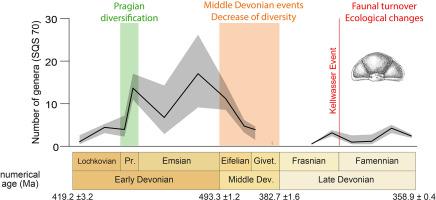Palaeogeography, Palaeoclimatology, Palaeoecology ( IF 3 ) Pub Date : 2021-01-01 , DOI: 10.1016/j.palaeo.2020.110208 Valentin Bault , Catherine Crônier , Ninon Allaire , Claude Monnet

|
Taking advantage of the exceptional record of Devonian trilobites in North Africa, a new dataset was compiled in order to reveal their long-term evolutionary history leading to their extinction. This dataset comprises 1171 trilobite occurrences from 168 different localities, within 22 consecutive and discrete chronostratigraphic intervals (substage temporal scale), representing 556 species, 179 genera, and 15 families scattered among nine North African basins. The reconstructed palaeobiodiversity trajectories by means of various biodiversity estimators of taxonomic richness are consistent and highlight a progressive and continuous diversification throughout the Early Devonian to reach a maximum of diversity at the end of the Emsian. Most families encountered in North Africa contribute to this increase of diversity. This regional diversification shows the same trends as the global one. Thereafter, the trilobite diversity began to decline due to extinction rates higher than origination rates during the Eifelian (Middle Devonian). From the middle Givetian to the late Frasnian, the trilobite diversity remained low. After this major decline, and the Frasnian events, a faunal change occurred, especially in phacopid and proetid trilobites, which were the only two families crossing the Frasnian/Famennian boundary. Indeed, the Kellwasser Event impacted an already impoverished diversity leading to a major faunal renewal associated with quick taxonomic changes at the genus level. A larger proportion of deeper water and reduced-eye/blind trilobites who acted as opportunists characterized the Famennian recovery. Finally, these palaeobiodiversity trends are compared to those of ammonoids from the same area.
中文翻译:

北非泥盆纪三叶虫生物多样性趋势
利用北非泥盆纪三叶虫的特殊记录,编制了一个新的数据集,以揭示导致它们灭绝的长期演化历史。该数据集包括来自168个不同地区的1171个三叶虫,出现在22个连续的和离散的年代地层间隔内(亚时间尺度),代表556种,179属和15个科,分布在9个北非盆地之间。通过生物多样性丰富度的各种生物多样性估算器重建的古生物多样性轨迹是一致的,并突出了整个泥盆纪早期的渐进性和连续性多样性,从而在艾美斯期末达到最大程度的多样性。在北非遇到的大多数家庭都为多样性的增加做出了贡献。这种区域多样化显示出与全球趋势相同的趋势。此后,三叶虫的多样性开始下降,这是由于在伊非尔时期(中泥盆世)灭绝速率高于原始发生速率。从中纪梵天到晚弗拉斯尼期,三叶虫的多样性仍然很低。在这一大幅度下降和弗拉斯尼亚事件之后,发生了动物区系变化,尤其是在蝶类和Proetid三叶虫中,这是穿越弗拉斯尼亚/法门尼边界的仅有的两个家庭。确实,凯尔瓦瑟事件影响了本已贫乏的多样性,导致重大的动物更新,而这与属类的快速分类学变化有关。法门尼亚人的恢复是作为机会主义者的较大比例的深水和双眼/盲人三叶虫的特征。最后,


























 京公网安备 11010802027423号
京公网安备 11010802027423号